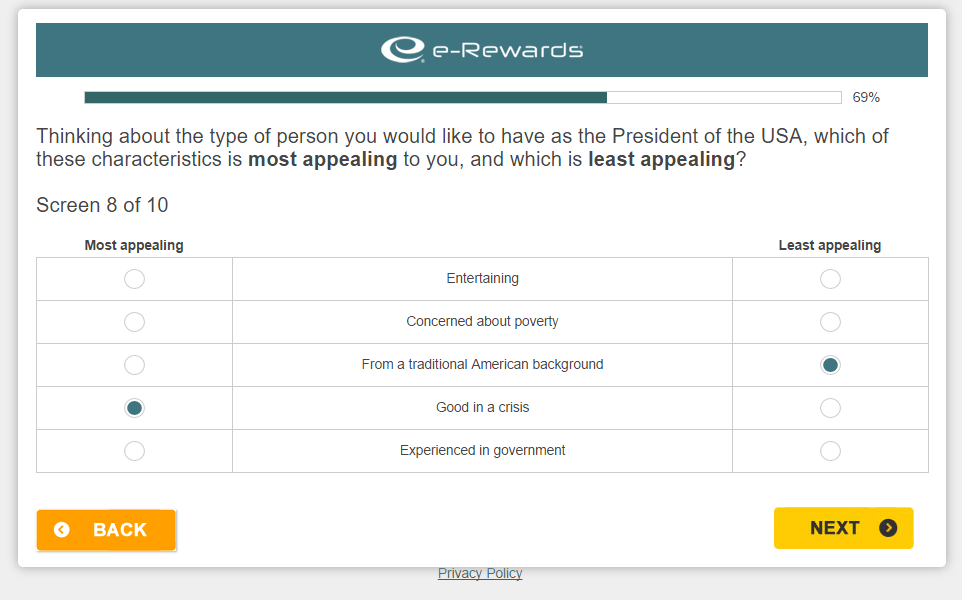
What is MaxDiff? Understanding Best-Worst Scaling

MaxDiff is a survey research technique for working out relative preferences. What do people like most? Second-most? Etc. It is useful in situations when simpler techniques – such as asking people to rate things or provide rankings – are considered likely to give poor data. It is also known as maximum difference scaling and best-worst scaling.
Understanding Best-Worst Scaling (MaxDiff)
Whether you call it MaxDiff or best-worst scaling, the goal is the same—to obtain clearer, more reliable preference data. If you ask shoppers to rank attributes like price, quality, convenience, brand reputation, etc, from 1 to 7, they might confidently choose their top and bottom choices, but positions 2 through 6 might be vague or inconsistent.
MaxDiff solves this by forcing respondents to repeatedly choose the best and worst attributes from smaller sets, leading to more meaningful and differentiated insights. It also provides valuable insight into how different attributes compare to one another.
Example of a MaxDiff question
A MaxDiff study involves presenting a sample of respondents with a series of questions, in which each question contains a list of alternatives. Respondents choose which alternative they like the most (best) and which the least (worst). The list of alternatives changes from question to question. I've provided an example, below.

Why do people use MaxDiff?
MaxDiff is used to resolve two practical problems with traditional rating scales:
- Poor discrimination between alternatives, with respondents in surveys, often rating multiple alternatives as very important, or 10, on a 10-point scale
- Yeah-saying biases, which are a type of response bias, whereby some respondents typically give much higher ratings than others
Consider the problem of working out what capabilities people would most like in the President of the United States. Asking people to rate the importance of each of the following characteristics would likely not be very useful. We all want a decent and ethical president. But we also want a president who is healthy. And the President needs to be good in a crisis.
We would end up with a whole lot of people rating the capabilities as 10 out of 10 for importance. Some people may give an average rating of 9, whereas others may give an average rating of 5, just because they differ in terms of how strongly they like to state things. MaxDiff is ideal in these kinds of situations.

Overview of the process when doing a MaxDiff study
There are five stages in a MaxDiff study:
- Creating a list of alternatives
- Creating an experimental design
- Collecting the data
- Statistical analysis
- Reporting
Outputs from a MaxDiff study
The end-point of a MaxDiff study is usually one or both of the following:
- A ranking of alternatives in order of preference. For example, if the study is being used for product-concept testing, the goal is to work out the relative appeal of the concepts.
- An understanding of differences between people in terms of their preferences for the alternatives. For example, a study examining preferences for product attributes may be designed as an input to a segmentation exercise, looking to find segments of people with different preferences.
MaxDiff vs Conjoint Analysis
Conjoint analysis is another technique that helps researchers uncover consumer preferences. Although it appears quite similar to MaxDiff on paper, the two techniques are actually very different.
While MaxDiff focuses on ranking individual attributes by preference, conjoint analysis looks more at how specific combinations of attributes influence an individual's decision. It is commonly used to assess consumer's sensitivity to price changes, forecast how product changes could affect market share, or predict how popular a new product will be.
MaxDiff, Concept Testing & New Product Development
One of the reasons MaxDiff is so effective is that it offers a realistic insight into people's purchasing behavior. By identifying the attributes shoppers value the most and forcing trade-offs, MaxDiff offers a structured way to prioritize specific features when concept-testing new products.
In new product development (NPD), MaxDiff is especially useful when testing product features, packaging designs, messaging, or pricing strategies. It helps researchers determine which elements drive consumer interest and which are less important. Unlike traditional rating scales, MaxDiff eliminates issues like "everything is important" responses, ensuring more reliable insights.
Paired with other concept testing methods, such as monadic testing or conjoint analysis, it helps businesses create offerings that truly resonate with their target audience.
Want to know more about MaxDiff please go to our Beginners Guide to MaxDiff? Head on over to the Displayr blog and check out more important market research topics!







